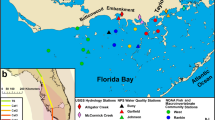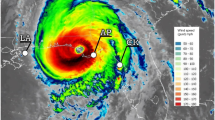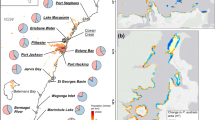Abstract
Hurricanes are some of the largest environmental drivers of change in coastal systems. We investigated the impacts of Hurricane Irma on benthic macrophyte communities in Florida Bay (FB) and the Florida Keys National Marine Sanctuary (FKNMS), USA. Spatiotemporal analyses were performed at multiple hierarchical levels (site, zone, region) to identify potential changes in the Braun-Blanquet (BB) densities of total seagrass (TSG) and total calcareous green macroalgae (TCAL) post-disturbance and to determine whether changes were attributable to hurricane impacts or normal seasonal and inter-annual variability. There were significant decreases in TSG in one of five zones in FKNMS and in one of six zones in FB, but no change in TCAL was recorded in either system. TSG in the Lower Keys Bayside declined from a mean BB score of 2.6 to 1.2, resulting from storm-induced erosion, whereas TSG in coastal FB declined from 1.05–2.4 to 0.36–2.0, likely due to prolonged hyposalinity and low dissolved oxygen following stormwater drainage. Overall, impacts to South Florida benthic macrophyte communities from Hurricane Irma were not catastrophic and were limited in spatial extent. Our results suggest that coastal areas hit by a storm with heavy winds are more likely to sustain direct physical impacts to the benthos, whereas estuarine areas with longer residence times are more at risk of the indirect effects of stormwater runoff and retention. Our analyses placed putative hurricane impacts within the context of recent variability and historical system baselines through the use of long-term monitoring data coordinated by multiple governmental and academic entities.







Similar content being viewed by others
References
Anton, A., J. Cebrian, C.M. Duarte, K.L. Heck, and J. Goff. 2009. Low impact of hurricane Katrina on seagrass community structure and functioning in the northern Gulf of Mexico. Bulletin of Marine Science 85: 45–59.
Ball, M.M., E.A. Shinn, and K.W. Stockman. 1967. The geologic effects of hurricane Donna in South Florida. The Journal of Geology 75 (5): 583–597.
Braun-Blanquet, J. 1972. Plant sociology: The study of plant communities. New York: Hafner Publishing Company.
Briceño, H.O., J.N. Boyer, J. Castro, and P. Harlem. 2013. Biogeochemical classification of South Florida's estuarine and coastal waters. Marine Pollution Bulletin 75 (1-2): 187–204.
Byron, D., and K.L. Heck. 2006. Hurricane effects on seagrasses along Alabama's Gulf Coast. Estuaries and Coasts 29 (6): 939–942.
Cangialosi, J.P., A.S. Latto, and R. Berg. 2018. Hurricane Irma. Tropical Cyclone Report. National Hurricane Center, 30 September 2018. 111 pp.
Carlson, P.R., L.A. Yarbro, K.A. Kaufman, and R.A. Mattson. 2010. Vulnerability and resilience of seagrasses to hurricane and runoff impacts along Florida's west coast. Hydrobiologia 649 (1): 39–53.
Cruz-Palacios, V., and B.I.v. Tussenbroek. 2005. Simulation of hurricane-like disturbances on a Caribbean seagrass bed. Journal of Experimental Marine Biology and Ecology 324 (1): 44–60.
Dingtian, Y., and H. Daojian. 2011. Impacts of typhoons Tianying and Dawei on seagrass distribution in Xincun Bay, Hainan Province, China. Acta Oecologica Sinica 30: 32–39.
Durako, M.J., M.O. Hall, and M. Merello. 2002. Patterns of change in the seagrass dominated Florida bay Hydroscape. In The Everglades, Florida bay, and coral reefs of the Florida keys: An ecosystem source book, ed. J.W. Porter and K.G. Porter, 523–537. CRC Press.
Ferrario, F., M.W. Beck, C.D. Storlazzi, F. Micheli, C.C. Sherpard, and L. Airoldi. 2014. The effectiveness of coral reefs for coastal hazard risk reduction and adaptation. Nature Communications 5 (1): 3794.
Fourqurean, J.W., and L.M. Rutten. 2003. Competing goals of spatial and temporal resolution: Monitoring seagrass communities on a regional scale. In Monitoring ecosystems: Interdisciplinary approaches for evaluating ecoregional initiatives, ed. D.E. Busch and J.C. Trexler, 257–288. Washington, D.C.: Island Press.
Fourqurean, J.W., and L.M. Rutten. 2004. The impact of hurricane Georges on soft-bottom, back reef communities: Site- and species-specific effects in South Florida seagrass beds. Bulletin of Marine Science 75: 239–257.
Fourqurean, J.W., A. Willsie, C.D. Rose, and L.M. Rutten. 2001. Spatial and temporal pattern in seagrass community composition and productivity in South Florida. Marine Biology 138 (2): 341–354.
Fourqurean, J.W., M.J. Durako, M.O. Hall, and L.N. Hefty. 2002. Seagrass Distribution in South Florida: A Multi-Agency Coordinated Monitoring Program. In The Everglades, Florida Bay, and Coral Reefs of the Florida Keys: An Ecosystem Sourcebook, ed. J.W. Porter and K.G. 497–522. CRC Press LLC.
Gallegos, M.E., M. Merino, A. Rodriguez, N. Marbà, and C.M. Duarte. 1994. Growth patterns and demography of pioneer Caribbean seagrasses Halodule wrightii and Syringodium filiforme. Marine Ecology Progress Series 109: 99–104.
Hall, M.O., B.T. Furman, M. Merello, and M.J. Durako. 2016. Recurrence of Thalassia testudinum seagrass die-off in Florida bay, USA: Initial observations. Marine Ecology Progress Series 560: 243–249.
IPCC, 2014: Climate Change 2014: Impacts, Adaptation, and Vulnerability. Part A: Global and Sectoral Aspects. Contribution of Working Group II to the Fifth Assessment Report of the Intergovernmental Panel on Climate Change [Field, C.B., V.R. Barros, D.J. Dokken, K.J. Mach, M.D. Mastrandrea, T.E. Bilir, M. Chatterjee, K.L. Ebi, Y.O. Estrada, R.C. Genova, B. Girma, E.S. Kissel, A.N. Levy, S. MacCracken, P.R. Mastrandrea, and L.L. White (eds).]. Cambrdige University Press, Cambridge, United Kingdom and New York, NY, USA, 1132 pp.
Klein, C.J., and S.P. Orlando. 1994. A spatial framework for water-quality management in the Florida keys national marine sanctuary. Bulletin of Marine Science 54: 1036–1044.
Lowe, R.J., J.L. Falter, M.D. Bandet, G. Pawlak, M.J. Atkinson, S.G. Monismith, and J.R. Koseff. 2005. Spectral wave dissipation over a barrier reef. Journal of Geophysical Research 110: C04001.
McClenachan, L., G. O'Connor, B.P. Neal, J.M. Pandolfi, and J.B.C. Jackson. 2017. Ghost reefs: Nautical charts document large spatial scale of coral reef loss over 240 years. Science Advances 3 (9): e1603155.
Narayan, S., M.W. Beck, B.G. Reguero, I.J. Losada, B.v. Wesenbeeck, N. Pontee, J.N. Sanchirico, J.C. Ingram, G.-M. Lange, and K.A. Burks-Copes. 2016. The effectiveness, costs and coastal protection benefits of natural and nature-based Defences. PLoS One 11 (5): e0154735.
NHC, N. 2017. Hurricane Irma public advisory 45a. National Hurricane Center, National Oceanographic and Atmospheric Administration.
Noguchi, K., Y.R. Gel, E. Brunner, and F. Konietschke. 2012. nparLD: An R software package for the nonparametric analysis of longitudinal data in factorial experiments. Journal of Statistical Software 50 (12).
Nuttle, W.K., J.W. Fourqurean, B.J. Cosby, J.C. Zieman, and M.B. Robblee. 2000. Influence of net freshwater supply on salinity in Florida bay. Water Resources Research 36 (7): 1805–1822.
Palandro, D.A., S. Andréfouët, C. Hu, P. Hallock, F.E. Müller-Karger, P. Dustan, M.K. Callahan, C. Kranenburg, and C.R. Beaver. 2008. Quantification of two decades of shallow-water coral reef habitat decline in the Florida keys National Marine Sanctuary using Landsat data (1984-2002). Remote Sensing of Environment 112 (8): 3388–3399.
Porter, J.W., P. Dustan, W.C. Jaap, K.L. Patterson, V. Kosmynin, O.W. Meier, M.E. Patterson, and M. Parsons. 2001. Patterns of spread of coral disease in the Florida keys. Hydrobiologia 460 (1/3): 1–24.
Preen, A.R., W.J.L. Long, and R.G. Coles. 1995. Flood and cyclone related loss, and partial recovery, of more than 1000 km2 of seagrass in Hervey Bay, Queensland, Australia. Aquatic Botany 52 (1-2): 3–17.
R Development Core Team. 2012. R: A language and environment for statistical computing. Vienna: R Foundation for Statistical Computing ISBN 3-900051-07-0, URL http://www.R-project.org/.
RAMMB, N. 2017. Aircraft-based tropical cyclone surface wind analysis. In AL112017 - major hurricane Irma: Regional and mesoscale meteorology branch. National Oceanic and Atmospheric Administration.
Robblee, M.B., T.R. Barber, P.R. Carlson, M.J. Durako, J.W. Fourqurean, L.K. Muehlstein, D. Porter, L.A. Yarbro, R.T. Zieman, and J.C. Zieman. 1991. Mass mortality of the tropical seagrass Thalassia testudinum in Florida bay (USA). Marine Ecology Progress Series 71: 297–299.
Sculley, S. 2018. After action report: Emergency measures due to high water conditions in the South Florida region during the 2017 wet season. Vol. 81. South Florida Water Management District.
Sierra-Rozo, O., B. Gavio, and J.E. Mancera-Pineda. 2012. Structure of Thalassia testudinum beds in old Providence island, Caribbean Colombian, after hurricane Beta. Caldasia 34: 155–164.
Thomas, L.P., D.R. Moore, and R.C. Work. 1961. Effects of hurricane Donna on the turtle grass beds of Biscayne Bay, Florida. Bulletin of Marine Science of the Gulf and Caribbean 11: 191–197.
Tilmant, J.T., R.W. Curry, R. Jones, A. Szmant, J.C. Zieman, M. Flora, M.B. Robblee, D. Smith, R.W. Snow, and H. Wanless. 1994. Hurricane Andrew's effects on marine resources. BioScience 44 (4): 230–237.
Tussenbroek, B.I.v. 1994. The impact of hurricane Gilbert on the vegetative development of Thalassia testudinum in Puerto Morelos coral reef lagoon, Mexico: A retrospective study. Botanica Marina 37: 421–428.
Webster, P.J., G.J. Holland, J.A. Curry, and H.-R. Chang. 2005. Changes in tropical cyclone number, duration, and intensity in a warming environment. Science 309 (5742): 1844–1846.
Williams, S.L. 1990. Experimental studies of Caribbean seagrass bed development. Ecological Monographs 60 (4): 449–469.
Acknowledgments
We would like to thank Christian Lopes, Kevin Cunniff, Rachel Lopez, Sonja Smith, Claudia Carrion, Brittany Nguyen, Manuel Merello, Donna O’Dell, Katie Toth, Mike Wheeler, and Robin Jung for field assistance. We are grateful to Everglades National Park and Mote Marine Laboratory for logistical support. We appreciate the comments from editors and three anonymous reviewers, which improved the manuscript greatly.
Funding
Funding for Florida Keys National Marine Sanctuary’s Water Quality Protection Program seagrass monitoring was provided by Environmental Protection Agency contract #X7-00D39015. Funding for Florida Bay seagrass monitoring was provided by the National Science Foundation through the Florida Coastal Everglades Long-Term Ecological Research Program under Grant No. DEB-1237517, and the South Florida Water Management District under the Restoration, Coordination and Verification Program. This is contribution # ___ from the Center for Coastal Oceans Research in the Institute of Water and Environment at Florida International University.
Author information
Authors and Affiliations
Corresponding author
Additional information
Communicated by Melisa C. Wong
Electronic supplementary material
ESM 1
(DOCX 41 kb)
Rights and permissions
About this article
Cite this article
Wilson, S.S., Furman, B.T., Hall, M.O. et al. Assessment of Hurricane Irma Impacts on South Florida Seagrass Communities Using Long-Term Monitoring Programs. Estuaries and Coasts 43, 1119–1132 (2020). https://doi.org/10.1007/s12237-019-00623-0
Received:
Revised:
Accepted:
Published:
Issue Date:
DOI: https://doi.org/10.1007/s12237-019-00623-0




